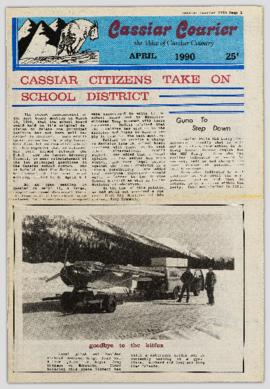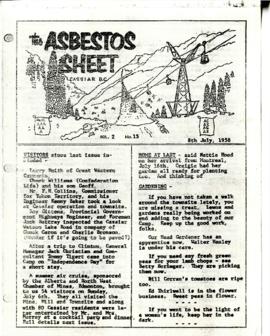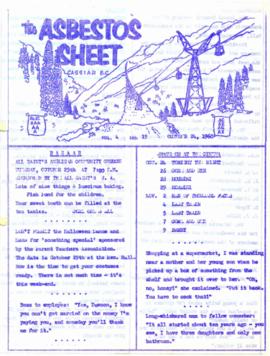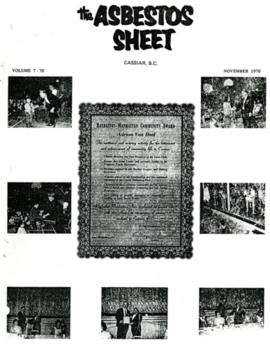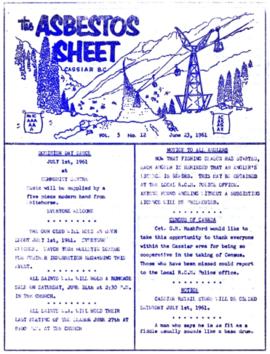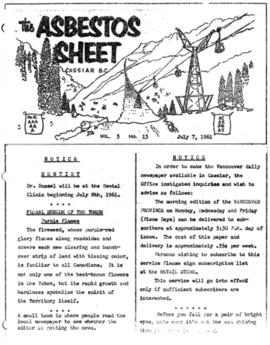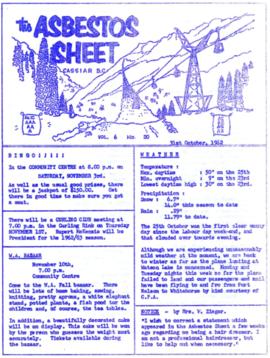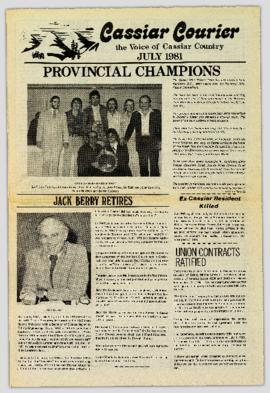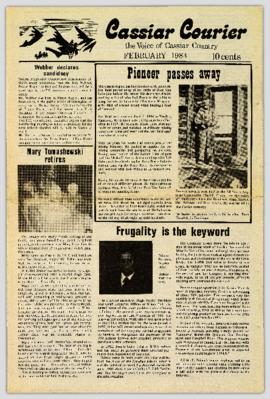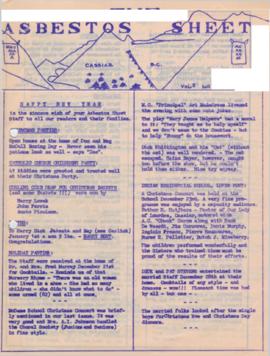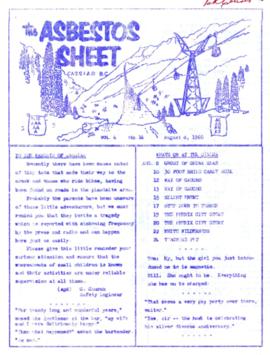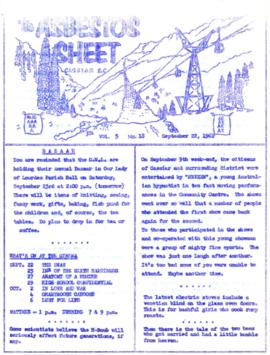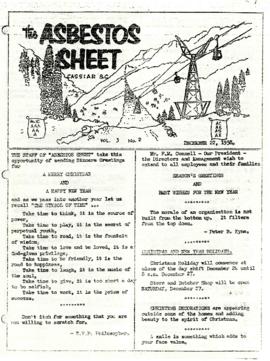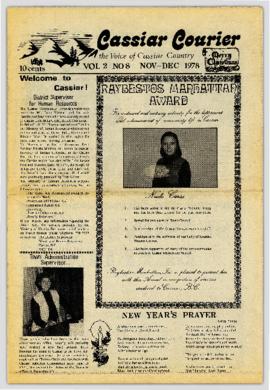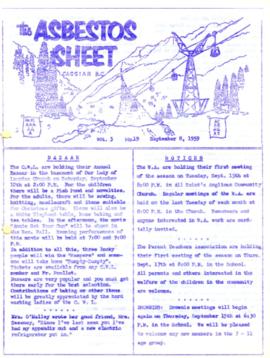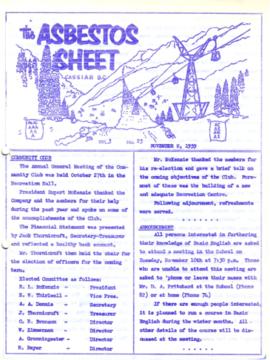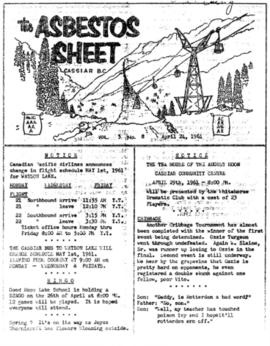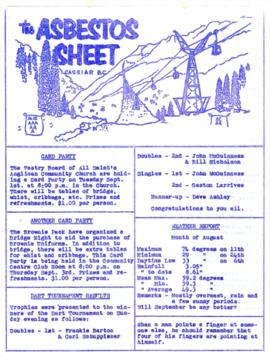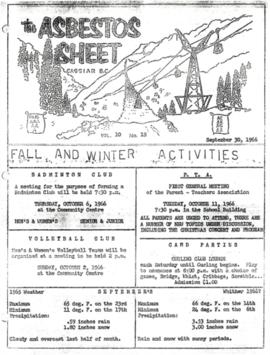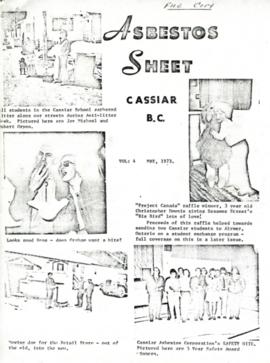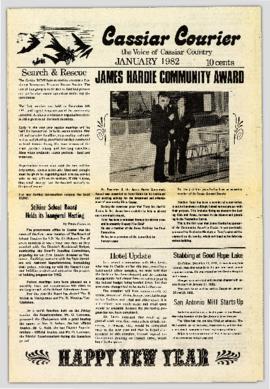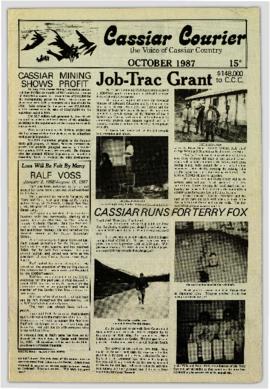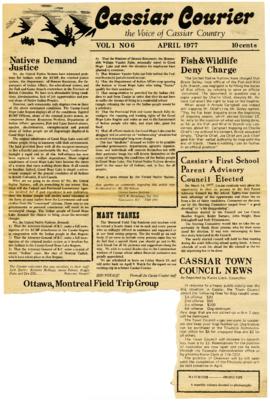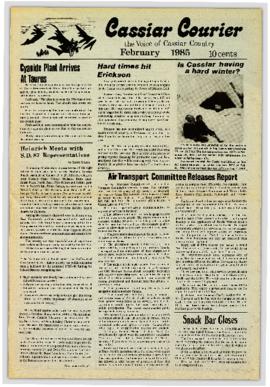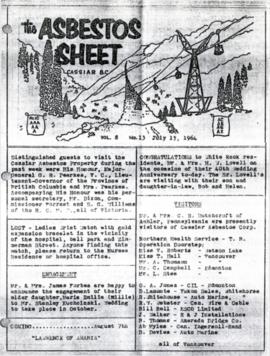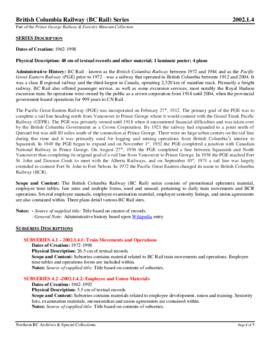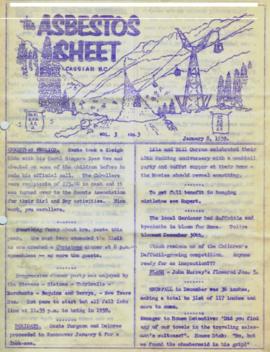File contains a minutes of the 1982 directors meeting of Maclaren.
James Maclaren Industries Inc.File contains various correspondence regarding the activities of the Maclaren company.
James Maclaren Industries Inc.Item contains the 1981 business plan for Maclaren.
James Maclaren Industries Inc.File contains a proposal to upgrade the current low yield sulphite mill to an ultra high yield system.
James Maclaren Industries Inc.File contains an informational package containing cost estimates, marketing strategies, financial information, environmental considerations, manpower, and training, regarding the expansion of the Thurso Kraft Mill.
James Maclaren Industries Inc.File contains correspondence, memoranda, other interoffice communications, and reports.
James Maclaren Industries Inc.File contains Adam Zimmerman's meeting notes, meeting agendas and minutes.
James Maclaren Industries Inc.File contains correspondence, meeting schedules, minutes, and notes regarding the purchase of Normick Perron by Noranda Forest Industries.
James Maclaren Industries Inc."The Cassiar Courier" is a newspaper that documents the community and work life of the residents of Cassiar BC. Content includes text and photographs, as well as jokes, comics, and games.
"The Asbestos Sheet" is a newspaper that documents the community and work life of the residents of Cassiar BC. Content includes text and photographs, as well as jokes, comics, and games.
"The Asbestos Sheet" is a newspaper that documents the community and work life of the residents of Cassiar BC. Content includes text and photographs, as well as jokes, comics, and games.
"The Asbestos Sheet" is a newspaper that documents the community and work life of the residents of Cassiar BC. Content includes text and photographs, as well as jokes, comics, and games.
"The Asbestos Sheet" is a newspaper that documents the community and work life of the residents of Cassiar BC. Content includes text and photographs, as well as jokes, comics, and games.
"The Asbestos Sheet" is a newspaper that documents the community and work life of the residents of Cassiar BC. Content includes text and photographs, as well as jokes, comics, and games.
File contains timber sale contracts and logging inspection reports between the Department of Lands and Forests and the Fichtner Lumber Company Limited.
"The Asbestos Sheet" is a newspaper that documents the community and work life of the residents of Cassiar BC. Content includes text and photographs, as well as jokes, comics, and games.
"The Cassiar Courier" is a newspaper that documents the community and work life of the residents of Cassiar BC. Content includes text and photographs, as well as jokes, comics, and games.
"The Cassiar Courier" is a newspaper that documents the community and work life of the residents of Cassiar BC. Content includes text and photographs, as well as jokes, comics, and games.
File contains correspondence, memoranda, interoffice communications, informational/promotional material, and reports on varying subjects.
James Maclaren Industries Inc.File contains executive correspondence regarding Maclaren and Northwood. Includes letters of resignation.
James Maclaren Industries Inc.Item contains the minutes from the 1980 Maclaren directors meeting.
James Maclaren Industries Inc.Item contains the minutes from the 1980 Maclaren directors meeting.
James Maclaren Industries Inc.File contains a minutes of the 1981 directors meeting of Maclaren.
James Maclaren Industries Inc.File contains a minutes of the 1982 directors meeting of Maclaren.
James Maclaren Industries Inc.File contains a copy of a report entitled "James Maclaren Industries Inc Newsprint Division - Newsprint Mill Modernization".
James Maclaren Industries Inc.File contains promotional material, a proposal by Maclaren to invest in Perron, snd minutes from a meeting of the executive committee.
James Maclaren Industries Inc.File contains correspondence, memoranda, other interoffice communications, and reports.
James Maclaren Industries Inc.File contains several copies of the Normick Perron annual report: 1980, 1981, 1982, 1984, 1986, 1987.
James Maclaren Industries Inc."The Asbestos Sheet" is a newspaper that documents the community and work life of the residents of Cassiar BC. Content includes text and photographs, as well as jokes, comics, and games.
"The Asbestos Sheet" is a newspaper that documents the community and work life of the residents of Cassiar BC. Content includes text and photographs, as well as jokes, comics, and games.
"The Asbestos Sheet" is a newspaper that documents the community and work life of the residents of Cassiar BC. Content includes text and photographs, as well as jokes, comics, and games.
"The Asbestos Sheet" is a newspaper that documents the community and work life of the residents of Cassiar BC. Content includes text and photographs, as well as jokes, comics, and games.
"The Cassiar Courier" is a newspaper that documents the community and work life of the residents of Cassiar BC. Content includes text and photographs, as well as jokes, comics, and games.
File consists of a videocassette (VHS) recording of the following:
- The Community as an agent for Change: a series of videotapes about the native people of the Stony [sic] Creek Band.
- Mary John and Bridget Moran speaking at the College of New Caledonia [incomplete version]
- Mary & Lazare John’s 60th Anniversary Party – Part I [incomplete version]
Videocassette Summary [1]
Title: The Community as an agent for Change: a series of videotapes about the native people of the Stony [sic] Creek Band.
Date: February 1979
Context: The Community as an agent for Change: a series of videotapes about the native people of the Stony (sic) Creek Band. Video produced by the Rural Resource Project, School of Social Work at the University of Victoria, 1979. Five women interviewed by an unidentified man (Q) include: Mary John (MJ), Sophie Thomas (ST), Celena John (CJ) and 2 unidentified women (A). Interview location: Stoney Creek reserve.
Introduction: Video begins with Mary and Lazare drumming and singing with other elders.
In Feb. 1979, the Rural Resource Project of the School of Social Work at the University of Victoria was invited to the Stoney Creek reservation to document their unique culture and to share their success in dealing with community issues especially those concerning the welfare of their children.
Identification of Vanderhoof, and the location of the Stoney Creek reservation
The Stoney Creek band encompasses 400 people. The band is a member of the Carrier Nation.
A: How the Carrier people got their name. Years ago, when a man died and the woman is still alive, they would build a big fire- they didn’t bury their dead in those days. They would put the corpse on the fire and burn it, while drums and dancing carried on; and this wouldn’t end until all was burnt. The widow would then pick up the ashes and put it in a bag and carry them wherever she went - for a year: that is how they got their name –Carrier. They carry their dead. When this year was up, her in-laws would hold a party for widow, if her people were good to her. They would dress her up and let her go. That is how they would treat their in-laws. That is how they were taught.
Q: In what ways did your people deal with problems before the welfare system?
MJ: In the old days when she was growing up, they didn’t have social problems. If there were problems such as quarrels or gossiping about one another, these [disruptive] people appeared before the hereditary chief and the watchmen- who were like councilors- like in a court. The chief would listen to both sides and then make a decision on how to solve problems. There were lots of ways they could solve problems. There was one man she remembered who was kind of like a social worker. After he had his tea in the morning he would go through the village into every house, and he would see to it that everyone had enough to eat for the day, and who was sick - he would do something about it. He would make sure people had enough food by getting others to give him some of their food and he would pass it along to the families who weren’t doing so well. He would give you a word of advice now and then. He was something like a social worker, he was really concerned about the whole village.
Q: How did the reserve as a community deal with problem children? Such as children who would stay out too late and cause problems for the parents.
A: The Chief would make a law for children who stay out too late at night. The Watchmen would take the children to Indian court and the Chief would fine them a $1. The children weren’t out late again. Things were strict back then.
A: They had severe laws. They would even have to kill [a troublemaker], or make that person go away – disown them when they did something really bad, like running around with another man’s wife. That was a crime and they would make them leave the band, or even kill them.
Q: You talk of your experiences as young girl growing up on the reserve. You talk about how self-sufficient you were with no reliance on welfare. What did you rely on?
CJ: The trap lines were just full. We had fishing rights – we could fish anytime we felt like it. We trapped according to season. We did berry picking too. We met all our provisions. All that was there they just had to do it and put food up for winter. It was hard but they got by. We would sell our furs and had money to buy any clothing or groceries they needed. We lived from the land. We had cattle, horses for transportation, and chickens and pigs - everything. We lived off the land. That was a good life.
Q: Young people today seem to have lost the ability to hunt and fish the way you used to; and a lot of the wildlife isn’t there anymore. Many people can’t get work and so rely on a welfare check. Do you think that is a problem on the reserve? They have a lot of free time with nothing to do.
A: Lots of boys graduate from highschool. The government spends lots of money on them. They graduate, they go back to reserve and have no jobs, they get frustrated and then turn to booze.
They need the help, they need jobs. There are no jobs here on reserve – nothing.
Q: How could we change the situation; the severe alcohol problems. What are some things you would like to tell social workers about the way they could help make a difference?
SJ: I don’t know how any social worker will help the people unless the people help themselves.
Q: Do you think things are getting worse?
MJ: This last year? I don’t think so. The drinking is getting worse. But I think the neglecting of children is not too bad, but the drinking is bad. A few people are drinking who have children.
But there are the regular ones.
Q: Some things were discussed at the Child Welfare Committee re: dealing with the alcoholic parents neglecting their children: that these parents shouldn’t just receive welfare, they should be made to do something for themselves like chop their own wood to keep their home warm. That would give them something to do so they wouldn’t be so bored.
MJ: That would help. She’s been thinking of all kinds of ideas. Why can’t they think of something that would pay for itself? One thing she was thinking about was raising fish. They are doing that in Duncan.
Q: Should the DIA maybe be involved in suggesting these sorts of things to help them use these kinds of resources?
MJ: Yes, to get rid of welfare system, they have to do something. [She is very much against welfare]. It has spoiled my people and they can’t undo it.
Q: What are your hopes for the future of your own people?
MJ: I hope someday they will smarten up.
Videocassette Summary [2]
Title: Mary John and Bridget Moran speaking at the College of New Caledonia [incomplete version]
Date: March 12, 1991
Context: Bridget Moran and Mary John speaking to students at CNC, specific class unidentified.
Introduction: Bridget identifies that she will make the introductory speech and Mary will answer any questions because Mary doesn’t like to make speeches even though she is very good at it….
Video recording breaks during Bridget’s introduction and resumes with MJ answering her first question.
MJ: …. She speaks about how free her people used to be. They could stop and make camp anywhere – this was no longer the case as all is private property. There are greater alcohol problems in north. They are holding workshops in Stoney Creek to help the young people. The older people know what to do, beadwork, etc. the young people don’t like to do traditional tasks, even for cash. The elders try to teach them. She has about 5 boys working doing wood for elders but they have no axe so she had to get one for them They are so poor on reserves. The elders try everything – elders tried a wood processing plant - for 10yrs they studied this. Had people from Switzerland and Germany lined up who wanted the wood but they still didn’t get anywhere….
Tape ends
Videocassette Summary [3]
Title: Mary & Lazare John’s 60th Anniversary Party – Part I [incomplete version]
Date: 11 June 1989
Context: Celebratory events for Mary and Lazare John’s 60th Wedding Anniversary, 1989.
Introduction: Party held in an auditorium. Head table in front of a curtained stage, decorated with a blue tablecloth. Streamers and pink, white and blue balloons provide a backdrop for the head table. Silver paper bells decorate the front of the table with a larger “60” sign on the front centre of the tablecloth.
There is a large wedding cake situated between Lazare and Mary on the centre of the head table. Pink and white balloons and streamers decorate the walls of the hall.
Video begins midway through the first dance between Lazare and Mary and ends soon after.
"The Asbestos Sheet" is a newspaper that documents the community and work life of the residents of Cassiar BC. Content includes text and photographs, as well as jokes, comics, and games.
"The Asbestos Sheet" is a newspaper that documents the community and work life of the residents of Cassiar BC. Content includes text and photographs, as well as jokes, comics, and games.
"The Asbestos Sheet" is a newspaper that documents the community and work life of the residents of Cassiar BC. Content includes text and photographs, as well as jokes, comics, and games.
"The Asbestos Sheet" is a newspaper that documents the community and work life of the residents of Cassiar BC. Content includes text and photographs, as well as jokes, comics, and games.
"The Asbestos Sheet" is a newspaper that documents the community and work life of the residents of Cassiar BC. Content includes text and photographs, as well as jokes, comics, and games.
This photograph album consists of photographs, membership cards and correspondence of Herbert F. Glassey. Subjects identified in this album include: automobiles, landscape vistas, hunting scenes, snowshoeing, dog sledding, provincial government offices and waterscapes. Identified geographic locations include: Nesutlane Trading Post, Atlin, Teslin Lake, Atlin Lake, McKee Creek, Taku Glacier and Otter Creek. The following of Mr. Glassey’s membership cards are also included within this album: “White Pass & Yukon Route, No. 308: Government Agent, Atlin account, 1939-1940”; “White Pass & Yukon Route, No. 283: Government Agent account, 1941-1942”; “Registration Certificate, 1940”; “The Wartime Prices and Trade Board, no.1305, 1942”; “Dominion Bureau of Statistics, no.252”; “The Society of Notaries Public Membership Card, 1956”; and “Prince Rupert Liberal Association, 1953”.
Glassey, Sarah"The Asbestos Sheet" is a newspaper that documents the community and work life of the residents of Cassiar BC. Content includes text and photographs, as well as jokes, comics, and games.
"The Cassiar Courier" is a newspaper that documents the community and work life of the residents of Cassiar BC. Content includes text and photographs, as well as jokes, comics, and games.
"The Cassiar Courier" is a newspaper that documents the community and work life of the residents of Cassiar BC. Content includes text and photographs, as well as jokes, comics, and games.
"The Cassiar Courier" is a newspaper that documents the community and work life of the residents of Cassiar BC. Content includes text and photographs, as well as jokes, comics, and games.
File contains timber sale contracts, logging inspection reports, and related maps between the Department of Lands and Forests and the Fichtner Lumber Company Limited.
"The Cassiar Courier" is a newspaper that documents the community and work life of the residents of Cassiar BC. Content includes text and photographs, as well as jokes, comics, and games.
"The Asbestos Sheet" is a newspaper that documents the community and work life of the residents of Cassiar BC. Content includes text and photographs, as well as jokes, comics, and games.
The British Columbia Railway (BC Rail) series consists of promotional ephemera material, employee time tables, fare rates and multiple forms, used and unused, pertaining to daily train movements and BCR operations. Several employee manuals, employee examination material, employee seniority listings, and union agreements are also contained within. Three plans detail various BC Rail sites.
British Columbia RailwayFile consists of a speech given by Gary Runka entitled "BC's Agricultural Land Reserve - Its Historical Roots" at the Post World Planners Congress Seminar.
Commentary on this speech by Barry Smith of the Ministry of Agriculture and Lands:
"Vancouver hosted the World Planners Congress in June 2006 and the day following the Congress the BC Ministry of Agriculture and Lands and Agriculture and Agri-Food Canada hosted a full day seminar entitled "Planning for Food".
GGR provided an important overview of the BC farmland preservation program. The speech begins with comments outlining the factors motivating the government of the day to enact legislation to preserve agricultural land. The presentation was then broken into three time periods including:
The Formative Years (1972-1975)
The Refinement Years (1976-1996)
The Uncertain Years (1996-????)
GGR in his summary poses some less than optimistic questions and observations. He states that despite successes "there are growing
concerns that, over its history, the focus of the program has subtly shifted - from an agency devoted to farmland preservation, to a rationing board." He sees the focus on application review as being detrimental to the Commission's role of promoting and encouraging farming in the ALR. Given this shift in direction he presents several suggestions to get the program back on track.
The presentation ends with a challenge to the people of B.C. to decide whether the next segment of the B.C. farmland preservation history is entitled 'The Rebuilding Years' or not."
"The Asbestos Sheet" is a newspaper that documents the community and work life of the residents of Cassiar BC. Content includes text and photographs, as well as jokes, comics, and games.
